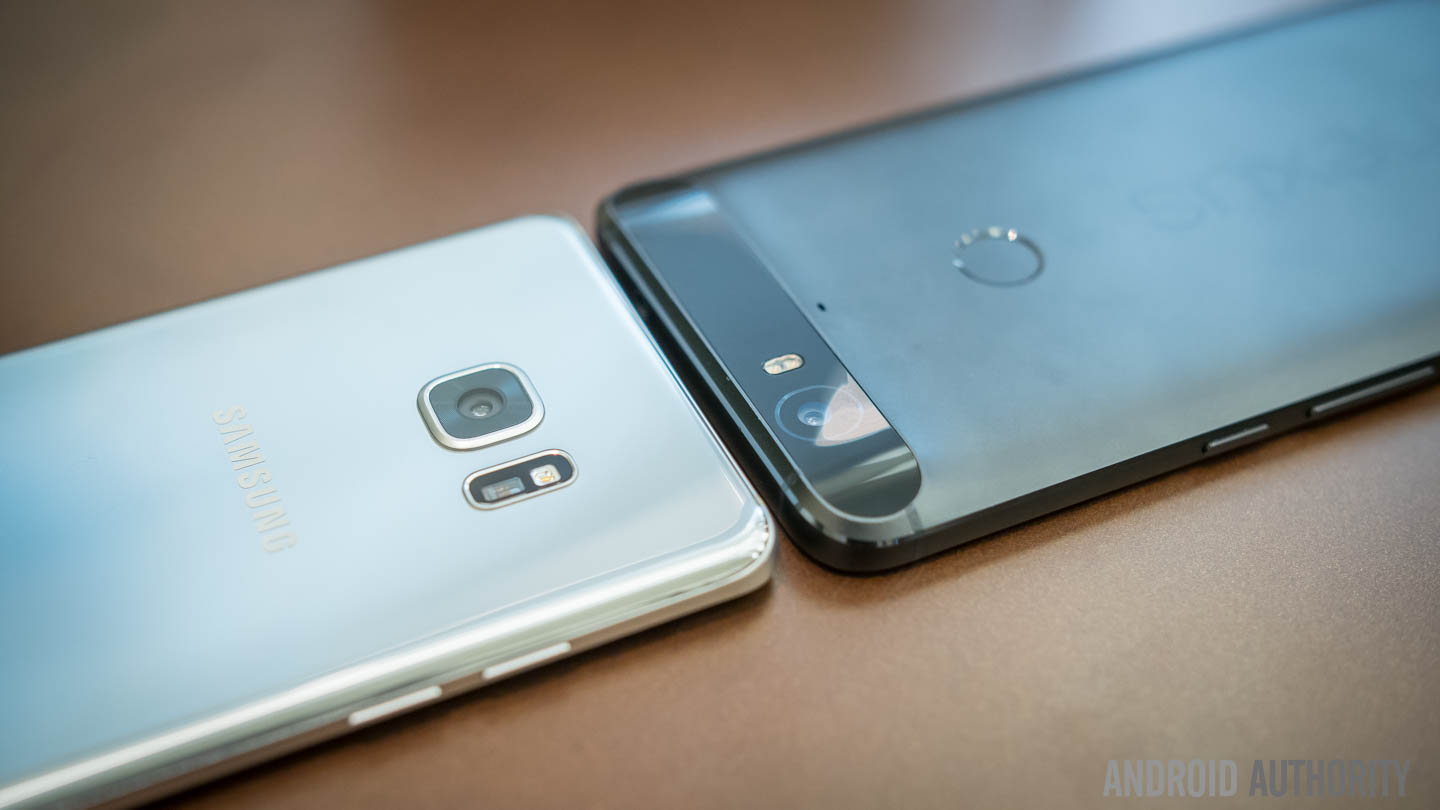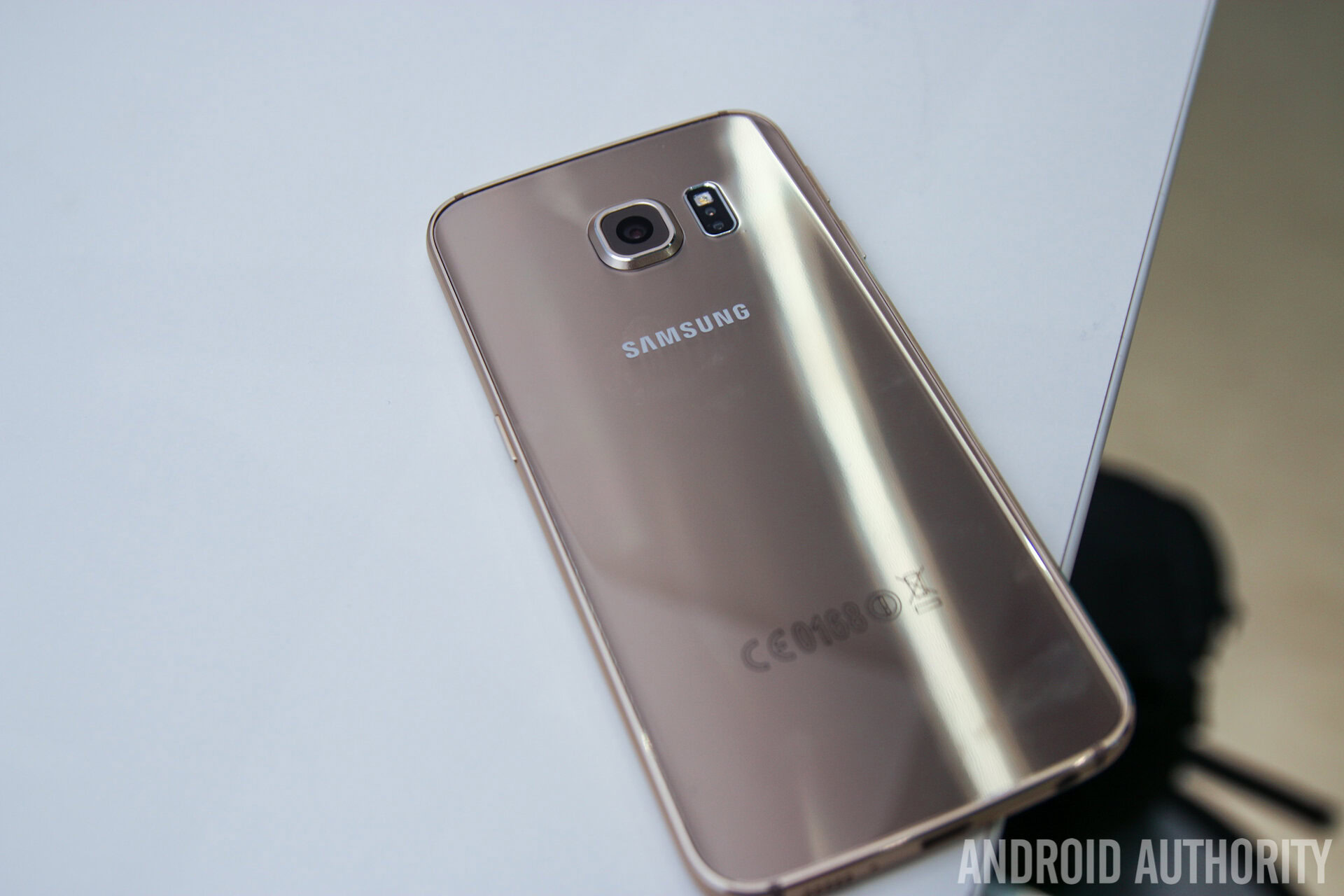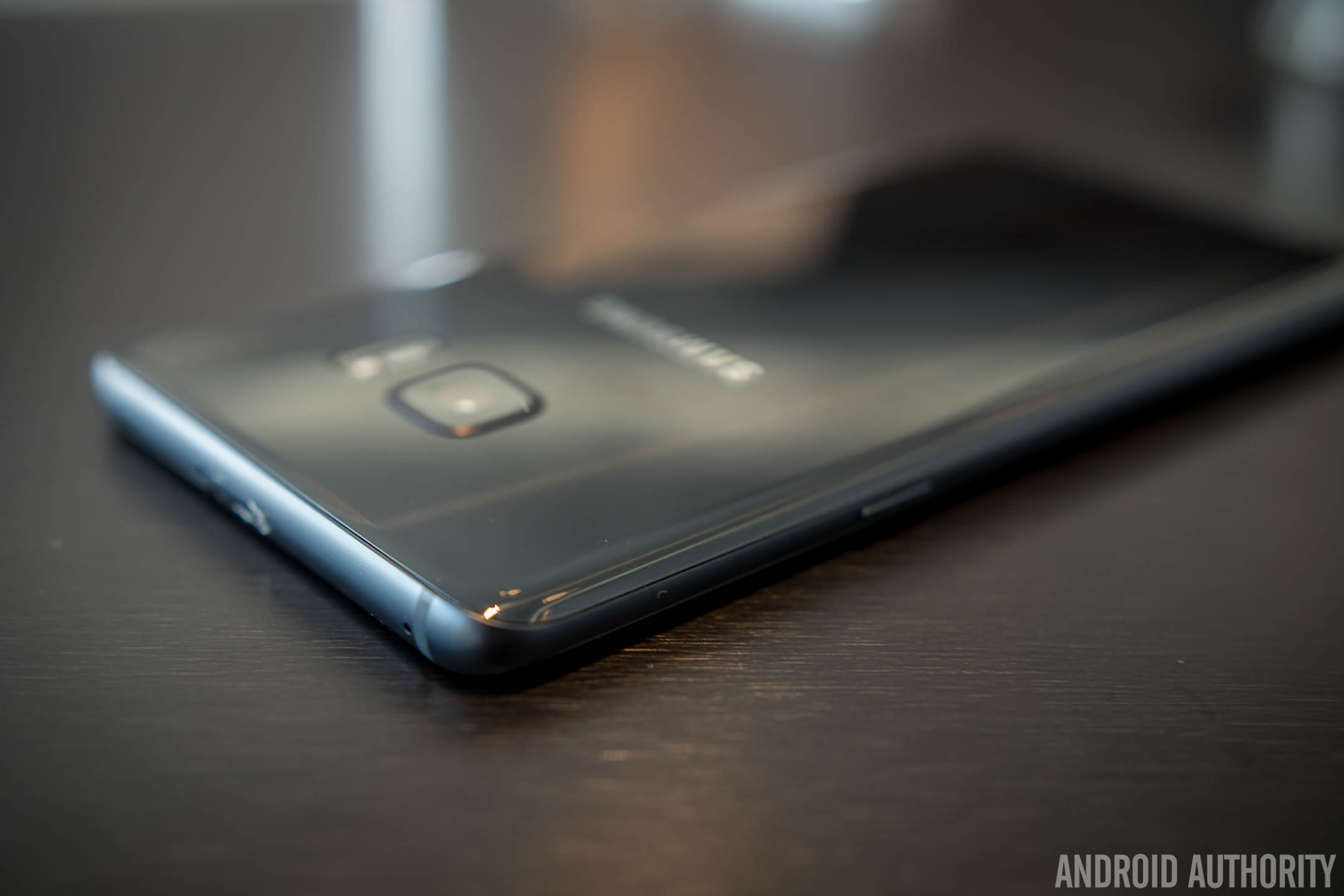Affiliate links on Android Authority may earn us a commission. Learn more.
Galaxy Note 7 vs the competition
August 2, 2016

Samsung’s Galaxy Note series is often held up as the pinnacle of phablet devices and now the Galaxy Note 7 has arrived with yet another selection of high-end specifications and new features. While not as heavily contested as the sub-5.5-inch flagship segment, there’s still plenty of consumer demand for large powerful smartphones. So let’s see how the Galaxy Note 7’s specifications stack up against some of the best in the field.
To enter into this contest, handsets much breach the 5.5-inch display mark. I’ve picked out the Nexus 6P, LG V10, HUAWEI Mate 8, and the Moto X Pure Edition (Style) as four of the best contenders. Those looking for slightly smaller handsets, might also find that the Xperia X5 Premium or the OnePlus 3 worth a look at.
| Galaxy Note 7 | Nexus 6P | LG V10 | HUAWEI Mate 8 | Moto X Style | |
|---|---|---|---|---|---|
Display | Galaxy Note 7 5.7-inch AMOLED 2560x1440, 518ppi | Nexus 6P 5.7-inch AMOLED 2560x1440, 518ppi | LG V10 5.7-inch LCD 2560x1440, 518ppi | HUAWEI Mate 8 6.0-inch LCD 1920x1080, 368ppi | Moto X Style 5.7-inch LCD 2560x1440, 518ppi |
SoC | Galaxy Note 7 Snapdragon 820 | Nexus 6P Snapdragon 810 | LG V10 Snapdragon 808 | HUAWEI Mate 8 Kirin 950 | Moto X Style Snapdragon 808 |
CPU | Galaxy Note 7 2x Kryo @ 2.15GHz 2x Kryo @ 1.6GHz | Nexus 6P 4x Cortex-A57 @ 2.0GHz 4x Cortex-A53 @ 1.55GHz | LG V10 2x Cortex-A57 @ 1.82GHz 4x Cortex-A53 @ 1.44GHz | HUAWEI Mate 8 4x Cortex-A72 @ 2.3GHz 4x Cortex-A53 @ 1.8GHz | Moto X Style 2x Cortex-A57 @ 1.82GHz 4x Cortex-A53 @ 1.44GHz |
GPU | Galaxy Note 7 Adreno 530 | Nexus 6P Adreno 430 | LG V10 Adreno 418 | HUAWEI Mate 8 Mali-T880 MP4 | Moto X Style Adreno 418 |
RAM | Galaxy Note 7 4GB LPDDR4 | Nexus 6P 3GB | LG V10 4GB | HUAWEI Mate 8 3 / 4GB | Moto X Style 3GB |
Memory | Galaxy Note 7 64GB UFS 2.0 | Nexus 6P 32 / 64 / 128GB | LG V10 32 / 64GB | HUAWEI Mate 8 32 / 64GB | Moto X Style 16 / 32 / 64GB |
MicroSD | Galaxy Note 7 Yes | Nexus 6P No | LG V10 Yes | HUAWEI Mate 8 Yes | Moto X Style Yes |
Starting as we always do, you’ll instantly notice a lot of similarities in the display section of our table. Most manufacturers seem to have settled on 5.7-inch panels as the sweet spot for larger smartphones, and a 2560×1440 (QHD) resolution offers up a little extra clarity with these big displays. Display clarity will be equal across these models, but some more subtle color and viewing angle differences may be noticeable across the range. The only exception here HUAWEI’s Mate 8, which opts for a larger 6.0-inch display with a reduced 1080p resolution, which will result in slightly less crisp images. That said, the Mate 8 does cost a bit less.
We’ve started seeing a lot more smartphone manufacturers make use of more vibrant AMOLED panels this year, but the only competitor to match Samsung’s Note 7 display type at this size is the Nexus 6P. Of course, Samsung’s latest Super AMOLED technology offers up some minor color improvements over the 6P’s display. The other three phones on our list opt for LCD technology, which doesn’t quite offer the same pop or deep blacks as AMOLED displays. Samsung has also chosen to only offer its curved dual-edge AMOLED design with this year’s Note 7, which offers a sleek look and some extra software features that you can’t find in any of these rivals.
There’s a lot more diversity on our list when it comes to processing power, and Samsung’s Galaxy Note 7 is the first major flagship phablet to make use of Qualcomm’s high-end Snapdragon 820 processor. This processor is the chip of choice for many of 2016’s slightly smaller flagship phones, so you’ll find equal processing power inside the likes of the HTC10, LG G5, and the Sony Xperia X Performance.

Benchmarks, for what they’re worth, show that Snapdragon 820 is the fastest chip around. However, most of the extra performance come into play thanks to its improved Adreno 530 graphics chip. CPU performance, and therefore day to day tasks, should perform pretty much identically across all of these handsets, although the Snapdragon 808’s lower high performance core count may hurt it in some instances.
Looking at the GPUs, there’s quite a performance gap between the Snapdragon 808’s mid-tier Adreno 418 and the Kirin 950’s Mali-T880 MP4. Gamers will definitely see extra performance from the newer 820 chip, and it even hands in notably more grunt than the Snapdragon 810. Given the very high resolution of these display panels, this GPU will certainly aid the Note 7’s performance and offers a major boost over last year’s Galaxy Note 5 (Exynos 7420).
Rounding off our look at the main processing components is memory. 3 or 4GB of RAM is plenty enough for multitasking, and the Galaxy Note 7 sits at the top of the group, along with the V10 and the more expensive Mate 8 model. The Note 7 only offers one internal storage option of 64GB, but that’s still a typical value across all of these phones and lends itself to plenty of space for pictures, movies and music. Samsung’s choice of fast UFS 2.0 memory might see apps and large files open up a little more quickly than its competitors that use eMMC. If 64GB isn’t enough, all of these phones apart from the Nexus 6P can be supplemented with a microSD card.

| Galaxy Note 7 | Nexus 6P | LG V10 | HUAWEI Mate 8 | Moto X Style (aka Pure Edition) | |
|---|---|---|---|---|---|
Cameras | Galaxy Note 7 12MP f/1.7 rear with OIS & PDAF 5MP f/1,7 front | Nexus 6P 12.3MP f/2.0 rear with laser AF 8MP f/2.4 front | LG V10 16MP f/1.8 rear with OIS & laser AF Dual 5MP f/2.2 front | HUAWEI Mate 8 16MP f/2.0 rear with OIS & PDAF 8MP f/2.4 front | Moto X Style (aka Pure Edition) 21MP f/2.0 rear with PDAF 5MP f/2.0 front |
Battery | Galaxy Note 7 3,500mAh | Nexus 6P 3,450mAh | LG V10 3,000mAh (removable) | HUAWEI Mate 8 4,000mAh | Moto X Style (aka Pure Edition) 3,000mAh |
NFC | Galaxy Note 7 Yes | Nexus 6P Yes | LG V10 Yes | HUAWEI Mate 8 Yes | Moto X Style (aka Pure Edition) Yes |
Fingerprint | Galaxy Note 7 Yes | Nexus 6P Yes | LG V10 Yes | HUAWEI Mate 8 Yes | Moto X Style (aka Pure Edition) No |
Fast Charge | Galaxy Note 7 Yes | Nexus 6P Yes | LG V10 Quick Charge 2.0 | HUAWEI Mate 8 Yes | Moto X Style (aka Pure Edition) Yes |
Extras | Galaxy Note 7 Wireless Charging, Samsung Pay, USB Type-C, IP68 water resistance | Nexus 6P USB Type-C | LG V10 Secondary display, 32-bit audio, shock resistant | HUAWEI Mate 8 | Moto X Style (aka Pure Edition) IP52 splash resistance |
Dimensions | Galaxy Note 7 153.5 x 73.9 x 7.9mm 169g | Nexus 6P 159.3 x 77.8 x 7.3 mm 178g | LG V10 159.6 x 79.3 x 8.6 mm 192g | HUAWEI Mate 8 157.1 x 80.6 x 7.9 mm 185g | Moto X Style (aka Pure Edition) 153.9 x 76.2 x 11.1 mm 179g |
It’s impossible to judge final camera quality without doing a head to head shootout, but based on the specifications we have a pretty good idea about how the Galaxy Note 7 should perform. The 12 megapixel dual pixel f/1.7 sensor matches the Galaxy S7’s specifications, which was an excellent performer when we last put it to the test.
Opting for larger pixel sizes at the expense of some resolution has also worked out well the the Nexus 6P. Although we were still pleased with the results produced by the more traditional higher resolution LG V10 and Moto X Style cameras too. Video shooters will want to pick from the Note 7, V10 or the Mate 8 as they come equipped with optical image stabilization. The only camera that we were so-so about at review time was the HUAWEI Mate 8’s. Front facing cameras are more varied still, and Samsung hasn’t opted to catch up with the 8 megapixels offered by the Nexus 6P or the HUAWEI Mate 8.
Moving into the handsets’ extras, Samsung again shows the industry how to squeeze as many features as possible into a smartphone. Fingerprint scanners, NFC, and some form of fast charging technology have become the standard, and only the Moto X Style drops the fingerprint scanner from the list. Android Pay will work on all of these handsets, thanks to NFC support. However, Samsung Pay is still a cut above thanks to its universally compatible MST technology.
[related_videos title=”The competition:” align=”center” type=”custom” videos=”654322,668973,643164,651620″]
Samsung also remains the only manufacturer to support two wireless charging standards by default and has also joined other manufacturers by offering a USB Type-C interface with the Note 7. Although above the 5.5-inch size, only the Note 7 and Nexus 6P are on the cutting edge of USB port technology right now. Speaking of power, the Note 7, Mate 8, and the Nexus 6P offer up the largest batteries. There’s little excuse for falling below 3,300mAh in these supersize handsets, and customers can expect slightly better battery life than the V10 or Moto X Style.
There aren’t many gimmicks to be found in these top-of-the-line models, although some consumers may not find too much use for the secondary display properties of either the Galaxy Note 7’s dual-edge display or the secondary ticker display on the front of the LG V10. Then again, some consumers firmly swear by these features, and Samsung did a good job at refining its Edge software with the S7, which is now available with the Note 7. There’s also some improved stylus support and extra features for those who find this long running Note feature particularly useful. It’s also worth mentioning the Note 7 adds waterproofing to the mix, following in the footsteps of the Galaxy S7 series.
Finally, we come to the much more subjective element of design and build. The Mate 8 and Nexus 6P cater well to those who prefer metal build materials, while Samsung has chosen to stick with its slick glass design. The LG V10 is also an interesting option thanks to its shock absorbent casing. Impressively, Samsung has produced a large phone that weighs a bit less than its competitors. The Note 7 is around 10g lighter than its closest rivals and 22g lighter than the hefty LG V10.

Wrap Up
As we have all come to expect from Samsung’s Galaxy Note range, the latest edition continues to refine an already well polished experience. The Note 7’s extras continue to help it stand out just a smidgen above the rest of the pack, complete with top-of-the-line hardware that we’ve come to expect. That being said, there are some very competitive pieces of hardware on offer from late last year, which can now be grabbed at very compelling price points. Especially when we consider that Samsung’s hasn’t fundamentally changed anything major since last year’s Note 5.
Of course, the successor to the LG V10 is right around the corner, and it might give the Samsung a run for its money. Do you think that Samsung is still on top of the phablet market with its Galaxy Note 7?